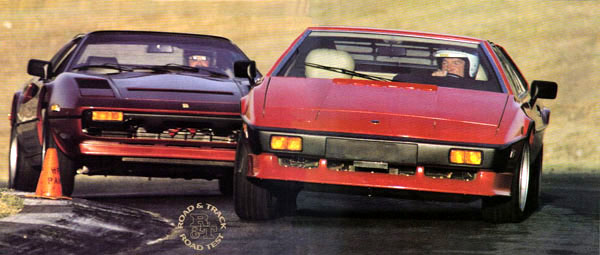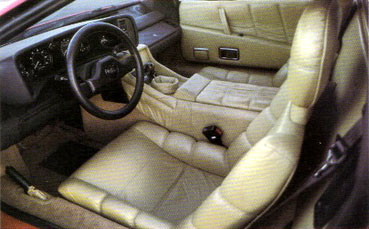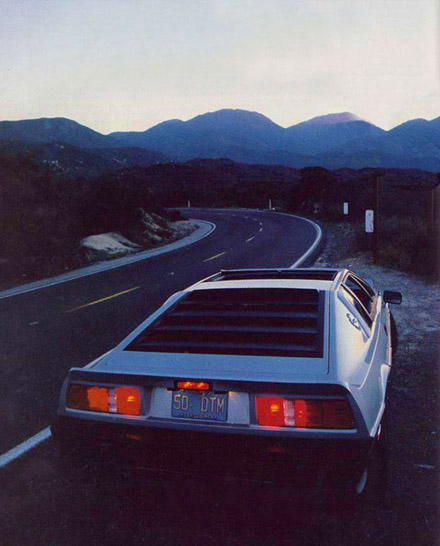
Road & Track Magazine - Road Test 1983
Lotus Turbo Esprit
Costly, fast and back in the game again at last
We were cruising north towards San Francisco on I-5, driving a bright red Lotus Turbo Esprit to Sears Point international Raceway for a day of track testing. We have a Ferrari 308 Quattrovalvole waiting there for the comparison purposes, and Dan Gurney would be flying in to do some test driving. Knowing the new Lotus would attract a lot of unwanted attention, we droving at exactly 55 mph. A motorcycle Cop pulled us over anyway.
"Just wanted to check your registration," he told us. " With those New Jersey plates you'll probably be stopped a lot."
Back on he highway, Assistant Engineering Editor Kim Reynolds pointed out another car with Jersey plates, a new Dodge wagon. "Why didn't he stop that car and check the registration," Kim asked, " or that Chevy with Colarado plates?" The obvious answer was that a Lotus Turbo Esprit doesn't blend into the traffic as well as a Dodge or Chevy, and the other possibility was that the Cop thought we didn't look like Lotus Turbo Esprit Owner's. Which of course begged a second question: just what does a real Turbo Esprit Owner look like?
If Lotus history is any help, the Esprit Owner should look knowledgeable, romantic, slightly eccentric, patient, long suffering and more than a little affluent. (We like to think it was onley for want of the last quality we were pulled over). Why these particlur traits? Because the enduring Esprit is that of a car lovely to look ar and rewarding to drive, but bedevilled by poor reliability and durability and a fading - if not absent dealernetwork.
The Lotus people at Hethel in Englnad have been painfully aware of these problems, both real and imagined, for some time. And after two years of marketing entanglements with Rolls Royce and absence from American showrooms, this is the year they have chosen to retrench and attach the U.S. market anew. Stocks have been sold to a limited number of heavy investors and a new marketing company called Lotus Performance Cars has been set up to sell the cars in the U.S. through, they hope, a select group of reliable and reputed dealers. The weapon in the renewed attack? For thisyear, at least, Lotus is bringing in just one model, the $47,984 Turbo Esprit.
As implied earlier, the Esprit is not a new car, even though the Turbo is new to the U.S. market. Its fibre glass body was designed in the early Seventies by none other than Giorgio Giugiaro, and the Series 1 Esprit was unveiled at the Paris Autoshow in 1975 (by coincidence, at the same time as the Ferrari 308 GTB). It replaced the strong selling Europa and marked a move by Colin Chapman away from the enthusiast's kit car into the upmarket world of Ferrari's and Porsche's. It's 2.0 liter 16-valve dohc alloy engine, designed by Tony Rudd, was also the first engine Lotus could claim entirel as it's own. The car was quick, nice handling and fragile.

Eight years later, the Esprit is still with us, but in current Turbo form it is scarely the same automobile that made its debut in 1975. That lovely Giugiaro body is still there, but changes have been made to improve aerodynamics and engine cooling. Early in the Esprit's development, a larger wrap-around air dam was added to scoop more air into the nearly horizontal radiator. With turbo-charging in 1980 came side skirts to accommodate the NACA ducts near the rear wheel wells. These feed air through the engine compartment to keep all that turbo gear cool, while small "ear" scoops behind the side windows collect air for engine breathing and added cooling. Flat bottom panels have been added to reduce body lift and spoilers are used at the tail and rear roof-line to balance the car's handing at high speed. the wind-shield is a flat glass panel, slightly inset into the A-pillars, which are extended forward to give the appearance of added rake.
The new 2.5 mph bumpers are nicely integrated into the body, though the ride height is slightly higher on the federalized version to comply with bumper height regulations. While some of our staff preferred the simpler, cleaner lines of the earlier Esprits, the added scoops and skirts have at least been put there for sound engineering reasons. In any case, they have given the car a chunky, purposeful look and others commented that the design has aged well and still looks as exciting as it did eight years ago.
Early Esprits had a rear suspension design that followed Chapman's weight-saving (and hub breaking) practise of using the rear half-shafts to act as upper suspension links. That is all changed now, and the Turbo had proper upper suspension links so the axles are called upon to do nothing but drive the rear wheels. One of the byproducts of Lotus' DeLorean connection was the construction of a "torture rack" for testing of frame rigidity. By running the Esprit frame on the rack, Lotus developed a stiffer steel back bone frame, more appropriate to the Turbo's added speed and cornering power. The back bone is also heavily galvanized now, to make it more corrosion resistant.
For those who like lots of willing horse power (and who doesn't?) the Turbo engine is also quite an improvement over its predecessors. Now displacing 2174cc, the all-alloy engine has four valves per cylinder, belt driven over head cams and sits at a 45 degree slant in the engine bay. A Garrett AiResearch turbo-charger aft of the engine pressurizes a pair of 45mm Dell'Orto twin choke carbs (the European version uses 40 mm Dell'Ortos, the the U.S gets the bigger carbs to compensate for the 3 stage catalytic converter and air injection). Redline is 7000 rpm, though a rev-limiter cuts our the ignition just slightly before the engine gets there. Claimed engine output is 205 bhp at 6000 rpm, with 194 Ib-ft of torque at 5000 rpm.
What do you get when you combine 205bhp with a curb weight of 2710 Lb (540 Lb les than the 230 bhp Ferrari 308 Quattrovalvole). You get a very quick car that shricks from 0 - 60 mph in just 6.6 seconds. That's quicker than the 6.8 second Ferrari, and also quicker than the Corvette and the Porsche 928S we rain in our August 1983 comparison test.As to top speed, we were able to substantiate Lotus' claim of 148 mph, making it the faster than the Ferrari's red-lining 142 mph ad again fster than the Corvette or Porsche. Suffice to say that the Lotus Turbo owner will not only be comfortable in fast compnay, but will find, more often than not, that he has no company at all.
You might expect a 2.2 litre engine with tha kind of performance to be annoyingly peaky or high-strung, but this is not entirely the case. It takes a few revs to get the Lotus cleanly off the line, but once the car is in motion the engine is marvelously torquey and quite flexible. Even in slow traffic driveability to adequate. Turbo lag is virtually nil in most driving situations, and the Esprit delivers the kind of smooth, uninterrupted thrust that keeps the Driver happily sunken in the seat. In passing situations, the Lotus makes most other cars on the highway look like born victims.
Driven back to back with the Lotus, the Ferrari has a smoother, more free-revving feel to the engine and makes lovelier mechanical sounds, but lacks some of the Lotus' mid-range punch. As Dan Gurney noted, "The lotus just feels like it's got more beans, especially when you're passing a line of cars."
The only hitch in the Turbo's power delivery occured during race track cornering at Sears Point and skid pad testing. Prolonged side loads in right-handers cause the carb floats to act up, feeding a rich mixture to the engine. The result is sooty exhaust smoke and power loss while exiting corners. This problem was not noticeable during the fast highway driving, but it hurts the cars throttle control and lap times at the track. The fuel injected Ferrari V8 was uneffected by high lateral G-load. A some what stiff hand operated choke is used to get the engine started in the morning, and the engine starts easily and quickly settles down to its normal, slightly lumpy idle. When hot, the engine is a little more reluctant to start and sometimes takes a bit of cranking. Sound insulation is good between the cockpit and engine compartment, and the only intrusive engine noise is a rather odd fluttering sound, presumably from the turbo wastegate, when you lighten up on the throttle between shifts.
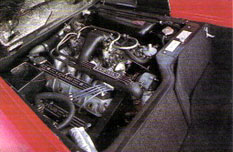
After enduring years of criticism over the Europa gear mechanism, Lotus Engineers went to some lengths to make the Esprit gearbox a pleasure to use, and they succeeded. The lever moves smoothly and easily, with a slight damped feel and there is never any doubt as to what gear you are selecting. The forward gears are in a standard H-pattern with 5th to the right and up. Reverse is back from 5th, protected by a lift lockout that takes a bit of effort. Otherwise the gearbox is pure velvet, enhanced by pedals that are in exactly the right place for heel and toe work. The Ferrari's gearbox has a harder, more mechanical feel and requires greater effort on the lever: more precise maybe, but not as easy to shift.
Lotus cars are Legendary for nothing if not their handling, and the Turbo Esprit is not a let down in that regards. As a starting point, the Lotus comes with 15 inch Goodyear NCT's mounted on light weight Mahle BBS wheels, so traction is up to the usual NCT standards. We recorded 0.811g of lateral acceleration at the skidpad - identical to the Ferrari's, thought a bit off the pace of the Porsche 944's 0.821g for example. How much the esprit was hampered by it's aformentioned fuel problem is hard to determine; suffice to say, had it's skidpan behaviour to the right been commensurate to its left-handed runs, we would have achieved a higher average lateral figure, though still decidedly inferior to the Chevrolet Corvette's 0.842g. By contrast, out Turbo Esprit's slalom speed of 62.2 mph would have put it at the head of that exoticar pack, with the the 944 and Vetter lying at 61.4 mph.
In more ordinary driving, the Lotus provides a delightful combination of comfortable ride, good steering feedback and predictible handling. In fast highway driing the car simply goes where it's pointed with an absolute minimum of transisitional upset, remaining flat and reutral through both fast and tight corners. On the race track and skid pan it pushes slightly to the right, probably due to the Driver's weight, and is essentually neutral to the left. In either case, the ready surplus of horse power makes it easy to steer the back end with your right foot, as long as the carbs are doing their job. Only when the tires are given side and longitudinal loads at the same time on a rough surface does the Lotus lose some of its rock-steady composure and get a bit twitchy.
However the brakes a disappointing for a car of this class, giving only average stopping distances: 154ft from 60 mph and 280 from 80. The Lotus rear discs like to lock up slightly before the solid (not vented) fronts, but the pedal is easily modulated and the tail can be kept comfortably behind you in most abrupt stopping maneuvers. Unfortunately, though, while you're modulating that rear lock up, the fronts are providing less than optimal retadation.
In terms of sheer ergonomics, the Turbo Esprit may be one of the most comfortable and livable exotics cars we've tested. Except for the somewhat restricted rear vision that normally comes with the territory in mid-engines cars, the Lotus is remarkably easy to lie with in day to day driving. We spent some long highway hours in the car between Los Angeles and San Francisco and found the seats quite comfortable despite their lack of rack adjustment. They also offer good side support at the hips for vigorous driving, without resorting to race seat technology and multiple adjustments. The Lotus is low, however, and this means this means that taller Drivers will find getting in and out something of an agility test. The center tunnel backbone is rather tall, but is provides a comfortable arm rest and an easy reach to the gearshift lever.
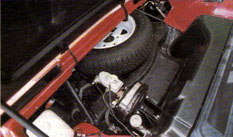
Our car had seats and door panels trimmed on soft tan Connolly leather, with a none-reflective black suede-like material covering the dash and instrument pod. The full set of Smiths intruments is easy to read, the excellent air conditioner is operated with simple, straight forward controls, and such items as the electric radio antenna is provided, but there's no radio. Lotus says Turbo Owners like to pick out their own.
Complaints? Wind noise. Quite a bit of it comes from the vicinity of the air scoops behind the rear windows, made more noticeable by the good sound insulation between the engine and Driver's compartment. On some other exotics you can't hear the wind noise from the cam chains.
Exterior finish, especially for a glass car, is positively first rate. One of our Staff toured the Lotus plant this last summer and was impressed with the body shop's almost obsessive attention to detail. Fibre glass parts are snded, checked, primed, sanded, checked for flaws, filled, sanded, checked, proimed, sanded etc. until they are siple without flaw. None of the parts, inside or out on our test car rattled of showed sign of poor fir or workmanship unbecoming of a $48,000 car. Lotus has launched an intensive factory campaign to upgrade its construction quality, and it seems to be paying off.
From all sides, the Turbo Esprit is an impressive car. It has everything we've come to expect from Lotus-speed, handing, and good looks, plus a few things we haven't come to expect, like comfort, a high level of detail finish and apparent durability. With a $48,000 price tag, the Turbo is up against some heavy hitters in the car market. The Lotus mystique has sold, and will probably continue to sell a certain number of cars. But in that price range a car has to be good or word of mouth will kill it. With that in mind, it's refreshing at this late date to drive a Lotus that succeeds on it's merits rather than mystique.
Lotusespritturbo.com © www.lotusespritturbo.com
